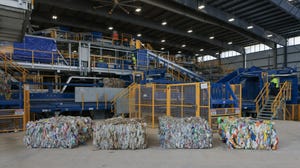Recycling Apps Evolving to Help Locate, Educate
Technology and trash disposal don’t typically mix, but recycling education efforts may be getting a needed boost through the rising use of smartphone apps.
Lindsey Rattan, director of communications for Earth911, says it’s very difficult for municipalities to communicate to residents and businesses the varied rules for each product. Her sustainability promotion group produces the app “iRecycle,” which directs users to the nearest recycling facilities and provides information about how to best dispose of products. It’s so difficult, she says, because there are more than 360 materials in the database and more than 122,000 recycling locations in the United States.
“Some people thank us because they tell us they would have thrown the item just straight in the trash because they can’t figure out how to recycle it,” Rattan says. “How to recycle plastics is our number one question we get, they just don’t know what the numbers mean. We help users figure out what to do, and help them find a place to take it.”
Many of the new apps, such as 1800Recycling, My Recycle List or Find Recycling, mirror iRecycle’s functionality. One major impediment to effective recycling, however, is the amount of research time needed to figure out where each product should go, especially since each municipality has separate rules based on their contracts with haulers and MRFs.
Recent months have seen some municipal solid waste departments release their own efforts. Waukesha County, Wisc., released an app in April. Dallas did the same in February. (There are also several apps to help reduce food waste.)
A new app launched this year called Recyche attempts to eliminate the research by using the product’s own label as instructions. The app, which is currently only available for Apple iPhones, can read a product’s UPC code and the phone’s location to determine the best recycling method.
Gary Greenblatt, co-developer of Recyche, says the app was born from a technology contest held in New York City, where developers vie to build apps that can solve big-city problems.
“The whole idea of the contest was to come up with a solution for a problem that people deal with every day,” Greenblatt says. “Well, New York City has pretty aggressive recycling efforts, so we tried to figure out how to tie technology to the problem. My wife says I always screw up the recycling—I never even know what to do with the milk cartons—so we came up with the idea to use the UPC code to build a database.”
He says while there are national associations and cities that publish extensive guides for recycling various plastic, glass and paper products, there’s no large database that can tell you how to recycle each one. Greenblatt says his group started with New York City’s rules, and then created a database for each type of product. More products are added each day using crowd-sourcing techniques, he says.
“You scan a 100-ounce bottle of Tide, for example, the UPC metadata doesn’t tell you how to recycle it,” Greenblatt says. “If our database doesn’t correlate to the product, then the app will ask the user to identify the product, such as a Plastic #2 – and that product will then be added into the database with instructions on what to do.”
His app originally only worked in New York, but is being expanded to 120 cities. The app not only provides recycling information, it also provides a personal recycling tracker for the user.
“We’re hoping to help make recycling a positive experience,” Greenblatt says. “If people can’t find an answer to something, they are likely to just give up. We want to provide quick information, while also getting a personal buy-in for making the world a greener place.”
About the Author(s)
You May Also Like


